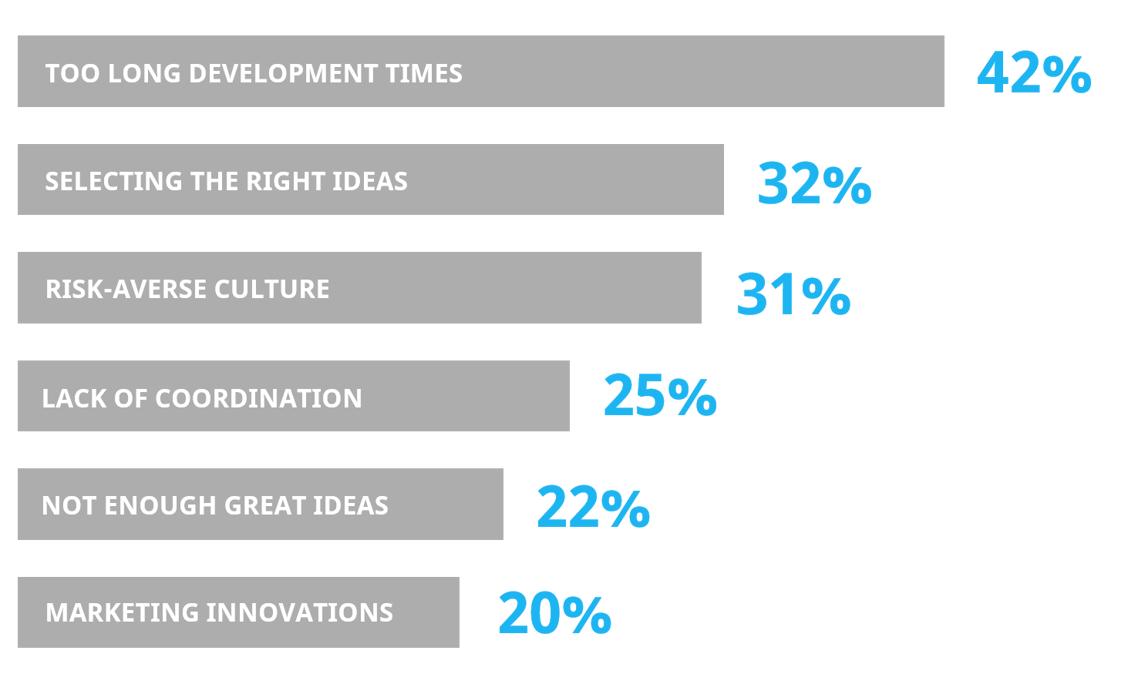8 Critical Success Factors for Idea Management
We’ve recently written quite an extensive post about idea management, its definition, processes, strategy and metrics, and scratched the surface of the factors that make idea management successful.

This time, we’ve decided to delve into the topic in more detail and share our key success factors and best practices for succeeding in managing your ideation process more effectively.
Table of contents
Idea management is an ongoing process
Idea management is a vital part of innovation management as both are crucial concepts for the long-term success of any organization.
In essence, successful idea management is about the ability to test, learn and implement ideas rapidly and efficiently.
Your goal is to get employees and other groups of people to contribute new constructive ideas and to see them through prioritization and development to a successful launch.

For an organization to increase the probability of succeeding in innovation, it simply makes sense to try to collect, manage and develop a large number of different ideas. Those who are focused on working on new ideas and constant improvement, have an increased chance to outperform their rivals.
The benefits and results of a systematic idea management process accumulate quickly. The more ideas you’ll be able to test, the more you’ll learn, and the more you’ll improve. Over time, those small improvements can prove to be significant.
Jim Collins summarizes the point quite well in his book Good to Great with the flywheel effect, which explains that the process resembles pushing a giant, heavy flywheel, building momentum until a point of breakthrough:
There was no single defining action, no grand program, no killer innovation, no solitary lucky break, no wrenching revolution. Good to great comes about by a cumulative process – step by step, action by action, decision by decision, turn by turn of the flywheel – that adds up to sustained and spectacular results.
– Jim Collins
What does a successful idea management process look like?
Successful idea management process is an entity where a large amount of ideas move forward in the process. The point is to implement the ideas that take the company towards its strategic goals.
A well-planned and executed idea management process optimizes the way you and your team work.
There are obviously areas that you’re good at and areas that need improvement. To be able to direct your efforts where needed, you must understand where you are, why you’re there, what your strengths are, and how to improve your performance.
You might already have some thoughts about how you want to manage your ideation process, but to learn how to make it even better, consider finding answers to the following questions:
- Which parts of the process are you good at?
- Where are you struggling?
- Where are the biggest bottlenecks?
According to BCG’s Global Innovation Study, some of the most common obstacles organizations face seem to be related to company culture as well as the selection and development of the ideas.

It’s equally important to work on shaping your culture and finding ways to generate better ideas, prioritize the ones with the most potential and implement them in a timely manner. If one area fails, it inevitably has a negative impact on other areas as well.
Idea management success factors
Identifying the aspects that make a process successful is fairly easy but putting things in practice is what requires more effort. Success isn’t about getting just one of the aforementioned aspects right – you need to make multiple things work.
The best way to do so, is to take a systematic approach to ideation. We've also come across a few common factors that are critical for successful idea management.
1. Link idea management to existing processes
Ideation shouldn't be a separate function in your organization but rather an integral part of the company's processes for developing the existing and the new.
Successful idea management processes integrate with the actual ways of working on all levels of an organization. Because different parts of the organization have different goals and processes, it's important to be able to link idea management to the existing ones.
New products often cannot be improved using the same processes you’re using for improving services or customer satisfaction, which is why you need to have multiple simultaneous processes at once.
If, for example, your sales team wants to improve customer satisfaction, it should build a process for gathering information about the most common issues and evaluate them against one another to see which one is the most urgent.
At the same time, other teams will focus on improving their ways of working, using structured and straightforward methods that take into account the existing limitations of the organization.
2. Have the right tools
Passive methods such as feedback forms and suggestion boxes aren't necessarily the best ones for managing managing the entire ideation process, especially when there are more active options available.
Here, the right idea management software can be tremendously helpful as it allows you to:
- involve more people in the innovation process
- help you improve the way you run the process
- receive and give continuous feedback
- link all the ideation activities together
In this context, the purpose of introducing new technology is to help direct the process and encourage people to participate more actively.
The right tool is flexible and considers changing organizational aspects while responding to them. The best tools are process-driven and support multiple different processes at once.
Keep in mind that it’s the execution that matters and while the right tools definitely help make the idea management process more efficient and effective, no tool will automatically make you more innovative.
3. Engage the right people
Ideas and innovations are often based on insights from end-users, but also from your employees, partners and customers. You can often find new interesting sources of ideas and feedback outside the organization.
To be able to find real solutions to real problems, it’s important to engage the right people in each stage of the process. If you’re working on a solution to your customer’s problem, for example, it obviously makes sense to talk to the customer first. In addition, people who are genuinely interested in the topic or who have experience on the subject are a good starting point.
Especially in large organizations, the biggest challenge is that not enough people are involved in working on understanding the problem and providing solutions for it.
Although having too many opinions will only complicate your decision-making process, it's important that people’s opinions are listened to.
4. Facilitate active discussion
Having the right tools, people and methods for managing ideas is a great start, but what you should really focus on is to facilitate a culture where active, value creating discussion thrives.
Too often, people are excited and motivated in the beginning, but if the conversation isn’t facilitated and kept alive, there’s a chance that the excitement fades.

Your goal is to build an active culture that reinforces the right habits. Once your culture and ways of working become more established, you shouldn't forget to keep activating and motivating people to ensure you’re making constant progress.
5. Rigorous project selection
When there are lots of ideas, systematic prioritization and project selection become even more important. Which ideas and projects to select depends on your strategic goals, capabilities and the level of risk you’re willing to take.
If you’re lacking focus and you’re reluctant to kill projects, your execution will suffer. The risk here is that if you're trying to focus on too many things at once, you'll never be able to give 100% to all of your projects.
Having too many projects can lead to poor performance, increased time to market and higher failure rates. To avoid these issues, you need to prioritize and validate ideas that have the biggest potential.
To ensure the right projects are selected, have rigorous criteria for project selection and make decisions based on data, not opinion or emotion. Often, there's no data you can use, so don't make the mistake of starting with too heavy experiments.
6. Involve the decision makers
According to The 2018 Global Innovation 1000 survey, companies with higher revenue growth compared to their competitors were much more likely to say their company’s executive team was closely involved with the R&D program — 78 percent said their executive team was highly or closely aligned with R&D investment and strategy, compared with 62 percent for same-growth companies, and 53 percent for slower-growth companies.
The Conference Board of Canada seems to confirm this, as according to them, managers who value and support innovation and who exhibit and exercise the right skills, attitudes, and behaviors, are crucial to success. Those who are business-educated, and who adopt best idea management practices are more likely to outperform other organizations on innovation.
Managers have the ability to influence performance and because the ones submitting the ideas aren’t always the ones making the decisions, leadership involvement is crucial to make sure that the decisions aren't made in isolation and that the best ideas will actually be implemented.
7. Allocate enough of the right resources
There’s no such thing as too much money, manpower or time, especially when it comes to innovation and idea management. Often, the real benefits of ideas can be seen after implementation but without enough resources, the entire innovation budget will go to waste.
What’s more important though, is to allocate the right resources as the most effective way to turn ideas into innovations isn’t necessarily to value quantity over quality. While you certainly need money to make ideas happen as it will buy you more time and manpower, acquiring the right talent is what matters.
One great employee is obviously better than ten bad ones. However, if you need to sell for millions, you probably need more than one great salesperson to do that.

What's actually quite surprising, is that based on the findings of The 2018 Global Innovation 1000 study, there is no long-term correlation between the amount of money a company spends on its innovation efforts and its overall financial performance. What matters instead, is how companies use that money and other resources to create products and services that connect with their customers.
Often, the more resources you have at your disposal, the less attention you’re forced to pay on how things are done in your organization. Sometimes, working with limited resources may reveal things about your implementation process you hadn’t been paying attention to.
8. Foster transparency
Last but not least, organization-wide cultural support is one of the keys to idea management. Each organization should pay attention to clear communication and transparency as these aspects have positive impacts on your culture.
Of all the aspects that support cultural innovation, transparency is perhaps the most important one as it enables learning and helps diving responsibilities.
Developing a transparent culture not only enhances effectiveness and increases engagement but also attracts people who are open to change. When people can see other’s ideas and the discussion has been made transparent, they’re likely to contribute more. Transparent feedback also empowers and rewards everyone involved.
To get valuable ideas and improvement suggestions, people need to feel comfortable about sharing their hopes and concerns. Making your idea management process more open can lead to increased sharing of knowledge. Be transparent about your successes and mistakes and the people are likely to do the same.
Lack of transparency can easily lead to a situation where feedback slows down, or new ideas go unnoticed. Without transparent processes, there’s a risk that the same things will be done multiple times or that no one will take the time to focus on implementing new ideas.
To avoid these types of issues, and to make real progress, you should make people responsible for certain ideas, hold them accountable and monitor progress.
Make it a habit
To succeed in idea management, you need to keep doing things differently. Idea management isn't just something that happens occasionally but it's rather an ongoing process that requires constant iteration.
We are what we repeatedly do. Excellence, therefore, is not an act but a habit.
– Aristotle
With a strategic, systemic approach to idea management, you'll increase your chances to succeed in the long term. As long as you're constantly working on coming up with new ideas and executing them, you're on the right path.
Next, you should define and implement a process for managing the ideas. To get started, you might want to read The Ultimate Guide to Idea Management Processes.
This post is a part of our Idea Management blog-series. In this series, we dive deep into the different areas of idea management and cover the aspects we think are the most important to understand about managing ideas.
You can read the rest of the articles in our series covering idea management by clicking on the button below. Don’t forget to subscribe to our blog to receive updates of our upcoming content!





